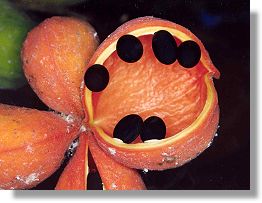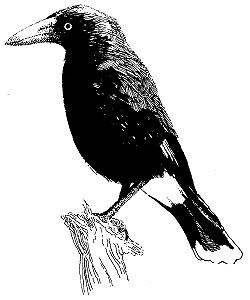The Bush Peanut
Sterculia quadrifida
Family: Sterculiaceae
This grove of trees is an interesting selection of beach ridge plants and includes Moreton Bay ash (Corymbia tessellaris), beach almond (Terminalia muelleri) and the peanut tree (Sterculia quadrifida) or bush peanut.
 |
The Bush Peanut (Sterculia quadrifida) |
The peanut tree is widespread along the Queensland coast. It normally occurs in monsoon forest vine thicket and along watercourses; here on Magnetic Island it is also found on older sand dunes.
A small-to-medium sized tree, it usually grows between 5 and 10 m tall and has a spreading canopy.
The leaves of the peanut tree are broadly egg-shaped and, occasionally, heart-shaped at the base. They are dark green above and paler below, and also have prominent veins.
The young bark is light grey and smooth, while the older trees have a darker, rougher, gnarled bark (seen here).
Inconspicuous greenish-white flowers are followed by a leathery, boat-shaped pod that ripens throughout the mid dry season (June-August). These split open to display a beautiful bright red interior that contains shiny, black, peanut-sized seeds that taste remarkably like peanuts, hence the name.
| |
| |
 |
Pied Currawong (Strepera graculina) |
| |
| |
The pied currawong (Strepera graculina) can often be seen feeding on the shiny, black, peanut-like seeds. The pied currawong is conspicuous by its absence in Townsville, restricted to the high hills around the city, such as Mt Stuart; it rarely ventures to the lowlands. On Magnetic Island, however, the currawong is one of the more common birds. Being a fierce competitor, it hunts out the nests of smaller birds and eats the eggs and chicks of the young.
One of the theories of the abundance of currawongs on the Island is the general absence of large numbers of black kites (Milvus migrans). Another theory is the number of native and exotic palms used in landscaping that now provide a year-round source of food through their palm fruit.
Other birds that may be seen in this grove are the pied imperial pigeon (Ducula bicolor) during the wet season, the red-tailed black-cockatoo (Calyptorhynchus magnificus) during the dry season, and sulphur-crested cockatoos (Cacatua galerita) all year round. |